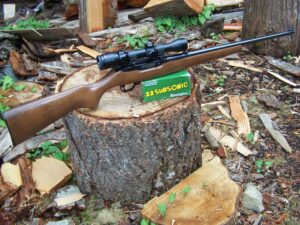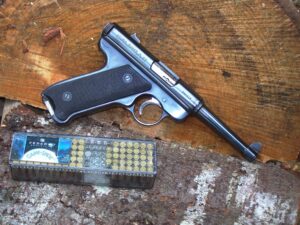
By Jim Dickson
Contributing Editor
For many years the .22 rimfire was a penny a shot and that price enabled many young shooters to become expert shots.
Back in those days I always fired 500 to 1,000 rounds of .22’s through my pistol every time I shot it. The main use of the .22 rimfire is as a training round and its lack of recoil and lower decibel level of noise made it perfect for that. If you try to fire that many centerfire rounds at one time the cumulative effect of the recoil will add up even if you are not noticing the recoil from the individual shots. Believe me, I know. As a gun writer I often have to put a lot of rounds through a gun in a very short length of time for my articles.
You simply cannot get the same amount of practice shots through a centerfire gun in one day as you can with a .22 rimfire.
As for noise levels, a .22 short gallery rifle doesn’t even go bang. It goes snap just like a muzzleloading Kentucky squirrel rifle. You still need hearing protection but it is nothing like the report of a .454 Casull. A really long barreled .22 like a British Martini-Henry converted to a .22 for a training rifle can be absolutely silent because the volumetric capacity of the primer and powder gasses has been reached in the bore before the bullet exited the barrel.

The 8 million new shooters who have recently become gun owners are getting the short end of the stick with .22 rimfire prices up as high as centerfire prices now. How are new shooters supposed to learn if the ammunition is priced out of reach? Some will turn to airguns but a lot of folks don’t consider an airgun a real firearm and the transition from airguns to centerfire guns is more difficult than moving up from a .22. Ultimately the .22 rimfire’s price will be the cause of its demise and the last rimfire cartridge will be discontinued just like it’s 19th century predecessors.
How did we get to this point?
When the first ammunition shortages fueled the panic buying, all prices went up as supplies went down. Rimfire ammunition is a high volume sales item with a low profit on individual sales.
No inexpensive practice .22 ammunition means less new shooters on board each year and more of the older shooters turning to less expensive pursuits. The customer base shrinks. As long as panic buying remains in place, supplies will likely remain tight.
(Editor’s Note: As this story was being prepared, Remington announced a “factory reboot” at its Lonoke, Arkansas facility. Now under the Vista Outdoors umbrella, the company released a video featuring Remington Ammunition President Jason Vanderbrink touring the plant and revealing his plans to “dramatically ramp up production, overcome supply chain issues, and demonstrate that the storied ammunition company is working overtime to address the needs of customers around the world.”)
As things return to normal ammunition manufacturers need the dedicated shooters to stay afloat. The .22 rimfire is the cartridge used to turn new shooters into accomplished, dedicated shooters and regular customers. This is important not just for the industry but for the entire shooting sports and gun rights movement.
Getting cheap .22 rimfire practice ammo back is critical to getting new shooters and keeping them in the game. Without a steady recruitment of new shooters, the shooting sports will see reduced participation as older gun owners age and die.
The availability of relatively inexpensive .22-caliber ammunition is almost like a pressure release valve, providing gun owners new and old the opportunity to continue pulling triggers, keeping in practice and improving their marksmanship.



